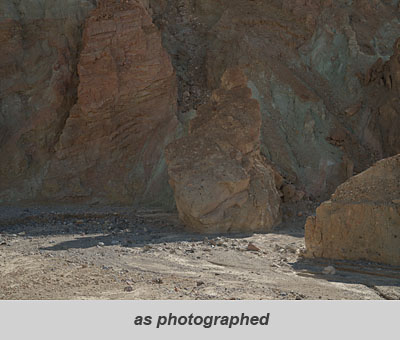About Mike's Technique |
Using a view camera for landscape photography has always been a rather slow and methodical process. Just unfolding and setting up the camera takes several minutes, and it's easy to spend another several minutes adjusting the camera's movements to establish perfect focus. Obtaining precise focus is the single most challenging part of the setup, and spending a few minutes focusing under the dark cloth also gives me some time to examine the overall image, and consider the composition. After sliding in the scanning back, a quick prescan lets me see the image and adjust exposure. My objective in the field is to capture as much high-quality information as possible, and not to be overly concerned with how it might appear at the time. False-coloring the prescan image quickly reveals any under- or over-exposure, as well as showing what range of data values each part of the scene will have. Unlike focus, establishing exact exposure is easier with the scanning back than with film, and the digital back has more dynamic range as well. Because of the camera setup time, my photographs are seldom spontaneous, and the lengthy scan times also favor relatively stationary subjects and steady illumination. However, many times I have been pleasantly surprised by how well windy scenes have been captured, and moving water is a study that I have only started to explore. My exposure technique and subsequent image modifications expand upon the Zone System teachings of the masters of black and white photography, and the computer provides far more precision, grace and subtlety than manual methods. I expect to have to adjust each photograph prior to printing, usually to selectively lighten and/or darken parts of the scene, or perhaps to reduce an unwanted color cast. Adjustments are made for both technical and esthetic reasons with the objective of making a printed image that tries to explain why I set up the camera in the first place.
|
